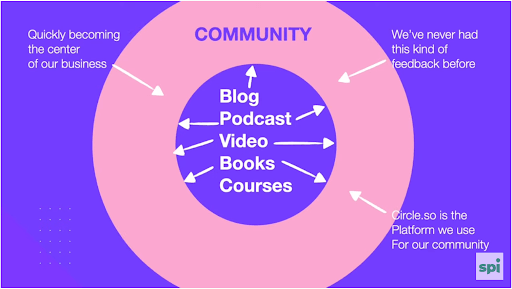At SPI, we’ve been all-in on community since the launch of our private membership community, SPI Pro. The growth of Pro has validated our sense that community isn’t just an exciting new piece of the business puzzle—it’s central to the future of business.
The COVID pandemic created a lot of isolation, and as we (hopefully) come out of it, we’re seeing a massive shift toward building and rebuilding community—including community-based businesses.
So what does it mean to build a community? Is it the same thing as building an audience? Not quite.
The two differ in a few important ways, and that’s what Pat Flynn and Matt Gartland covered in the first session of CX Day, a joint streaming event hosted by SPI and Circle.so on March 23.
In this post, the first of three covering the sessions at CX Day (find part 2 here), I’ll share the key differences between building an audience and building a community.
The 4 Key Differences Between Audience Building and Community Building
There are four major differences between a business geared toward audience building and one centered around community.
1. The objectives are different.
When you’re trying to build an audience, people come to find content (blogs, podcasts, videos, books, courses). They’re looking for information and answers.
But in a community model, people come with different objectives. They’re looking for human connection and belonging. They may come for the content, but they stay for the community.
In SPI’s case, we’re quickly moving toward a model where community is the center of our business, and our content leads people to the community.

2. The business models are different.
In an audience-based business model, your efforts are geared around getting people’s attention. And the tactics, tools, and strategies you’ll use to grab that attention are probably familiar: search engine optimization (SEO), affiliate marketing, paid ads, and sponsorships.
In a community-based model, though, the focus is not as much on gaining people’s attention, but on retention—keeping people around. The techniques used in an audience-building model may still apply, but for a different purpose. They’re geared toward bringing people into the fold and “holding onto them” with subscriptions, memberships, coaching, events, and masterminds.
3. The user experiences are different.
The user “avatar” also differs in an audience-based model compared to a community-based one.
In the audience model, the user’s point of view skews toward that of a consumer. They come to you on their own to find and consume your content. They may learn something new, then move on once they’ve gotten what they needed. If you do things well, they might subscribe to your email list to continue hearing from you.
In a community-based model, your users are more like members. They come to you to learn something new, but they stick around because you’re providing them with a place where they can belong. You’re giving them an opportunity to feel more connected, to find accountability and support, to build relationships with others on similar paths.
4. The operating conditions are different.
The conditions for operating an audience-based business versus one focused on community are also different—in significant ways.
How you staff—you need people who know how to build and cultivate a community!—the culture you create, your cost structure… will all vary depending on whether you’re building an audience or a community.
There’s a lot to think about, and I won’t dig too deep into those differences in this post.
Instead, I encourage you to tune in to the replay of Matt and Pat’s conversation from CX Day!
They go through the differences between audience and community building in detail, answer community-related questions from the CX Day audience, and share more about where SPI is headed in the future.
(Spoiler: Community is a big part of it!)
Here are a few pieces of feedback just from that first session.



Ready to Launch Your Community? We Want to Help
You could even make a case that people took community for granted before the pandemic pushed us all apart, and there’s now a desire to be more intentional about belonging.
We launched SPI Pro in July 2020 because we saw that desire in our space. People want to belong again. Someone needs to step up and offer that space in your niche. Will it be you?
Not to put too fine a point on it, but if you’re not at least thinking about building community, you’re playing a dangerous game.
And if you are thinking of building a community? It’s going to need a home. Circle [affiliate link] is far and away our favorite community platform, and it’s what we use for SPI Pro.
Also check out our April 4 post, where I dive into the second session from our March 23 CX Day event on how to make your community more valuable, with Andy Guttormsen and Alexis Teichmiller of Circle.
And don’t forget to subscribe to the Smart Passive Income YouTube channel, where we’ll be providing a lot more great community-focused content in the weeks and months to come. It’s where we host all our event replays, including last year’s Open Circle sessions on building and managing successful, engaged communities.
 Ray Sylvester
Ray Sylvester


